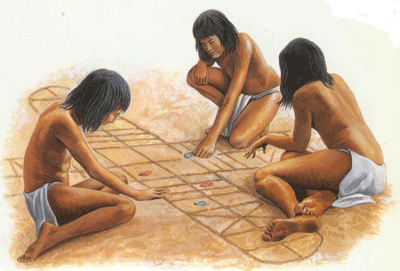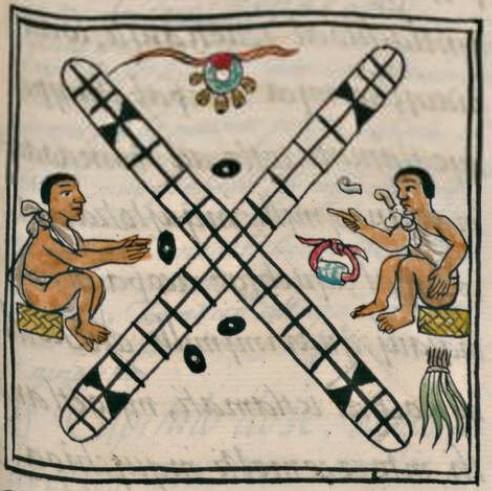What wouldn’t you bet while watching a fierce ball game where the players were not afraid to hurt themselves? A kernel of maize? A good obsidian knife? A golden necklace studded with precious stones?
Well, why not? Like anywhere else around the globe, people of the Mexican Valley and its surrounding, the Lowlands and Highlands alike, loved to gamble. Throughout important altepetls, small villages and regular towns, commoners or nobles, warriors or peasants, men or women, they all could be found betting, with patolli, a bean game, being the most popular of them all.
 Patolli was a game of luck and skill, requiring practice and a measure of strategic thinking, while the player depended on the caprice of the rolling beans as well.
Patolli was a game of luck and skill, requiring practice and a measure of strategic thinking, while the player depended on the caprice of the rolling beans as well.
The players would gamble whatever they felt fit – from blankets, to food, to precious stones, to their freedom even, and the onlookers would hold their breath, liking to watch the game as much as they liked to participate in it.
In the alleys of the marketplace or in the warriors’ camps, in the Palaces and the dwellings of the nobles as much as in the cane-and-reed houses of the poor, crowded neighborhoods, people would challenge each other readily, trusting Xochipilli, the god of gambling, to watch over their luck. Xochipilli – the Prince of Flowers (xochitl – flower, pilli – prince or child) – was the patron of art and beauty, gambling, dancing and music, and feasts. Before the beginning of the game he would be offered sincere prayers, and sometimes even a part of the offerings out of the betting pool.
The board, in a form of a cross, could have been drawn upon the ground, or embroidered on a reed mat, or carved on the floor or a table, and, probably, arranged in a beautiful mosaic all over the Palaces and the houses of the nigh nobility. It would always present 52 landing positions, as this number was sacred according to the calendar. And so was the number four, which would be also represented on the patolli board in the form of the four colored middle squares. A figurine of the player would better not land there for more than one round, as if caught by the figurine of the opponent it would be kicked from the board, resulting in one of the bets switching hands.

Another dangerous area were the triangles on the edges of the board, as landing one’s figurines there the player would be required to transfer to his opponent one of the bets right away.
Twelve figurines would commence the race up the board. Six for each player, unless more than two contesters were involved, and then the number of figurines would be divided accordingly.
The goal of the game was to move one’s figurines across the board, from the starting squires to the finishing ones. To do that the players would cast the beans (the word patolli means beans), that marked with a dot on one side of each bean.
In order to place one’s figurine on the board the player needed to throw his beans until it displayed only one dot, with the other four showing their blank sides. From there the players would move their figurines according to the number of dotted sides each toss of the beans displayed – two dots, two moves, three dots, three, but if all the beans would display their dots the lucky man’s figurine would jump ten squires all at once.
Each figurine that would complete its round across the board would win its owner a bet. Six figurines, six bets. And so someone would go away richer, and happier, than the other.
Totoloque was a simpler game, but one that required more skill and fitted the warriors best. The players were to toss small pellets as close to the target as possible. Each player had five tries and the one who would score more hits would win the bet.
And so, between wars and politics and betting games, the people around Lake Texcoco would not complain of boredom, most of the times.
An excerpt from “The Warrior’s Way”
Tecuani cast the beans and watched them rolling over the crude wooden surface.
Three of the beans stopped, displaying their marked sides while the other two remained blank. Absently, he picked a wooden figurine and moved it three squares up.
When he leaned back against the wall, his opponent, a warrior, but of a more common type, grabbed the beans.
“Just don’t fall asleep on us, kid,” he commented to the merriment of the others.
“No. I’ll collect your bets first, then I’ll go to sleep.” Tecuani shut his eyes against the strong midmorning light, his head pounding. He shouldn’t have drunk all that octli last night.
The man snorted. His throw of beans produced only one point, one bean displaying its marked side. Not a bad throw. The man whooped and flung another figurine onto the board.
“Who is collecting whose bets now, eh?”
“No one, yet.” Tecuani shrugged and tossed the beans. This time each displayed its marked side. Five points, ten squares. A lucky throw. Contemplating which of his figurines to move up the board, he paid no attention to the excitement of the watchers – mostly market frequenters and a few of his fellow warriors.
“Lucky frog-eater,” murmured his opponent.
One of the watching warriors raised his cup of octli. “Tecuani is always lucky with beans.”
Who cared about the stupid beans? Tecuani leaned back against the wall, fighting the urge to close his eyes. It was true. His luck would usually hold whenever he played the bean game. Since he’d been a boy he would win many bets, free to spend them on the marketplace afterward. But it had nothing to do with luck. If one played skillfully, one could always manipulate the figurines to the best of one’s ability. People were stupid to assume it was up to the rolling beans and marks.
While his opponent took his time to whisper a prayer, Tecuani’s thoughts drifted. Not cheerful thoughts for once. Since the warriors had left for Lake Chalco, more than half a moon ago, he had had no moment of peacefulness and not much of that alleged luck of his. His wound had healed perfectly, but not in time for him to join the campaign. Oh, how he craved to fight with Atolli, side by side, to show his brother, that outstanding man, once and for all that he, Tecuani, was not a child anymore. What a perfect opportunity, spoiled by a filthy wound.

Have you ever considered giving talks about the Aztecs etc in schools and what not, Zoe? You’ve got a wealth of knowledge and it’s such a neglected area. I’m sure there’d be some schools that would jump at the chance of having you pop in to give a presentation or a talk.
D.S, thanks you so very much for your warm feedback! 🙂
I think it could be a great idea, but for my dreadful accent 😀
As it is I think I would better stick to writing fiction and non-fiction, where no one can hear how I pronounce the words 😀
Love history. I am glad I visited your page. Great job!